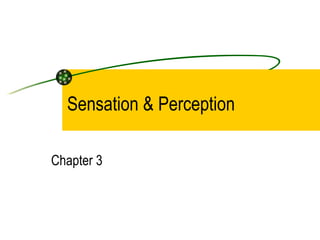Chapter3 Gen
•Télécharger en tant que PPT, PDF•
3 j'aime•3,967 vues
The document discusses sensation and perception. It defines sensation as the stimulation of the senses and perception as how we organize and interpret sensations. It then discusses the sequence of events involved in sensation, including stimulation of sensory receptors and transmission of signals to the brain. Finally, it briefly outlines several senses like vision, hearing, smell, and touch, and discusses perceptual processes.
Signaler
Partager
Signaler
Partager

Contenu connexe
Tendances
Tendances (19)
S. Sherrill - General Psychology - Chapter 3 power point

S. Sherrill - General Psychology - Chapter 3 power point
En vedette
En vedette (14)
Reach slides handout day II (2 slides per pg miller & chow, 16)

Reach slides handout day II (2 slides per pg miller & chow, 16)
The outcome of psychotherapy yesterday, today and tomorrow (psychotherapy in ...

The outcome of psychotherapy yesterday, today and tomorrow (psychotherapy in ...
Similaire à Chapter3 Gen
Similaire à Chapter3 Gen (20)
Chapter 3 Psych 1 Online Stud 1199408234400754 3[1]![Chapter 3 Psych 1 Online Stud 1199408234400754 3[1]](data:image/gif;base64,R0lGODlhAQABAIAAAAAAAP///yH5BAEAAAAALAAAAAABAAEAAAIBRAA7)
![Chapter 3 Psych 1 Online Stud 1199408234400754 3[1]](data:image/gif;base64,R0lGODlhAQABAIAAAAAAAP///yH5BAEAAAAALAAAAAABAAEAAAIBRAA7)
Chapter 3 Psych 1 Online Stud 1199408234400754 3[1]
Plus de fiedlert
Plus de fiedlert (9)
Dernier
Trichy Call Girls Book Now 9630942363 Top Class Trichy Escort Service Available

Trichy Call Girls Book Now 9630942363 Top Class Trichy Escort Service AvailableGENUINE ESCORT AGENCY
Pondicherry Call Girls Book Now 9630942363 Top Class Pondicherry Escort Servi...

Pondicherry Call Girls Book Now 9630942363 Top Class Pondicherry Escort Servi...GENUINE ESCORT AGENCY
Call Girls Ahmedabad Just Call 9630942363 Top Class Call Girl Service Available

Call Girls Ahmedabad Just Call 9630942363 Top Class Call Girl Service AvailableGENUINE ESCORT AGENCY
Dernier (20)
💕SONAM KUMAR💕Premium Call Girls Jaipur ↘️9257276172 ↙️One Night Stand With Lo...

💕SONAM KUMAR💕Premium Call Girls Jaipur ↘️9257276172 ↙️One Night Stand With Lo...
Trichy Call Girls Book Now 9630942363 Top Class Trichy Escort Service Available

Trichy Call Girls Book Now 9630942363 Top Class Trichy Escort Service Available
Mumbai ] (Call Girls) in Mumbai 10k @ I'm VIP Independent Escorts Girls 98333...![Mumbai ] (Call Girls) in Mumbai 10k @ I'm VIP Independent Escorts Girls 98333...](data:image/gif;base64,R0lGODlhAQABAIAAAAAAAP///yH5BAEAAAAALAAAAAABAAEAAAIBRAA7)
![Mumbai ] (Call Girls) in Mumbai 10k @ I'm VIP Independent Escorts Girls 98333...](data:image/gif;base64,R0lGODlhAQABAIAAAAAAAP///yH5BAEAAAAALAAAAAABAAEAAAIBRAA7)
Mumbai ] (Call Girls) in Mumbai 10k @ I'm VIP Independent Escorts Girls 98333...
Call Girl In Pune 👉 Just CALL ME: 9352988975 💋 Call Out Call Both With High p...

Call Girl In Pune 👉 Just CALL ME: 9352988975 💋 Call Out Call Both With High p...
Night 7k to 12k Chennai City Center Call Girls 👉👉 7427069034⭐⭐ 100% Genuine E...

Night 7k to 12k Chennai City Center Call Girls 👉👉 7427069034⭐⭐ 100% Genuine E...
Pondicherry Call Girls Book Now 9630942363 Top Class Pondicherry Escort Servi...

Pondicherry Call Girls Book Now 9630942363 Top Class Pondicherry Escort Servi...
Call Girls Vadodara Just Call 8617370543 Top Class Call Girl Service Available

Call Girls Vadodara Just Call 8617370543 Top Class Call Girl Service Available
Top Rated Bangalore Call Girls Majestic ⟟ 9332606886 ⟟ Call Me For Genuine S...

Top Rated Bangalore Call Girls Majestic ⟟ 9332606886 ⟟ Call Me For Genuine S...
Call Girls Ahmedabad Just Call 9630942363 Top Class Call Girl Service Available

Call Girls Ahmedabad Just Call 9630942363 Top Class Call Girl Service Available
Call Girls Visakhapatnam Just Call 8250077686 Top Class Call Girl Service Ava...

Call Girls Visakhapatnam Just Call 8250077686 Top Class Call Girl Service Ava...
Independent Call Girls In Jaipur { 8445551418 } ✔ ANIKA MEHTA ✔ Get High Prof...

Independent Call Girls In Jaipur { 8445551418 } ✔ ANIKA MEHTA ✔ Get High Prof...
Top Rated Hyderabad Call Girls Chintal ⟟ 9332606886 ⟟ Call Me For Genuine Se...

Top Rated Hyderabad Call Girls Chintal ⟟ 9332606886 ⟟ Call Me For Genuine Se...
Call Girls Hosur Just Call 9630942363 Top Class Call Girl Service Available

Call Girls Hosur Just Call 9630942363 Top Class Call Girl Service Available
Call Girls Gwalior Just Call 8617370543 Top Class Call Girl Service Available

Call Girls Gwalior Just Call 8617370543 Top Class Call Girl Service Available
Russian Call Girls Lucknow Just Call 👉👉7877925207 Top Class Call Girl Service...

Russian Call Girls Lucknow Just Call 👉👉7877925207 Top Class Call Girl Service...
Call Girls Shimla Just Call 8617370543 Top Class Call Girl Service Available

Call Girls Shimla Just Call 8617370543 Top Class Call Girl Service Available
VIP Hyderabad Call Girls Bahadurpally 7877925207 ₹5000 To 25K With AC Room 💚😋

VIP Hyderabad Call Girls Bahadurpally 7877925207 ₹5000 To 25K With AC Room 💚😋
Call Girls Service Jaipur {9521753030} ❤️VVIP RIDDHI Call Girl in Jaipur Raja...

Call Girls Service Jaipur {9521753030} ❤️VVIP RIDDHI Call Girl in Jaipur Raja...
Jogeshwari ! Call Girls Service Mumbai - 450+ Call Girl Cash Payment 90042684...

Jogeshwari ! Call Girls Service Mumbai - 450+ Call Girl Cash Payment 90042684...
Call Girls Rishikesh Just Call 8250077686 Top Class Call Girl Service Available

Call Girls Rishikesh Just Call 8250077686 Top Class Call Girl Service Available
Chapter3 Gen
- 1. Sensation & Perception Chapter 3
- 3. Sequence of events that produce a sensation: 6. You respond! 5. Signal reaches the brain. 4. As a signal passes along sensory nerves to CNS, it is further coded. 3. Receptor sends out a coded electrochemical signal. 2. Stimulates a receptor cell in a sense organ (energy must be sufficient enough for receptor to respond). 1. Need a form of energy, either external or internal.